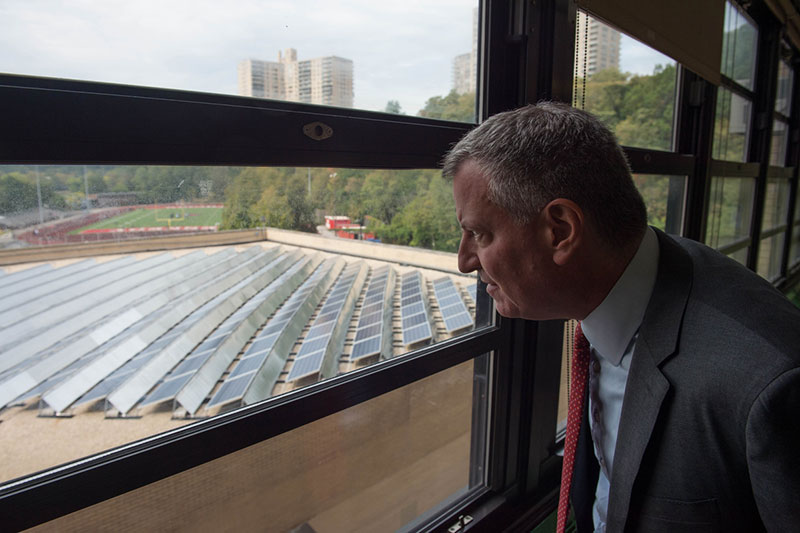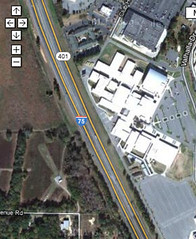Solar high schools: not just for
Dublin, Georgia anymore.
 New York City, and Rochester, NY, too!
How about solar Lowndes High School?
Or the new Valdosta High School?
Or since Valdosta has already
put solar at its Mud Creek Wastewater Treatment Plant,
how about on other city buildings?
How about on the county palace?
Or in Hahira, Dasher, Remerton, or Lake Park?
New York City, and Rochester, NY, too!
How about solar Lowndes High School?
Or the new Valdosta High School?
Or since Valdosta has already
put solar at its Mud Creek Wastewater Treatment Plant,
how about on other city buildings?
How about on the county palace?
Or in Hahira, Dasher, Remerton, or Lake Park?
Erin Durkin wrote for New York Daily News 29 September 2014, 24 NYC schools getting solar panels in $28M project — and City Hall could be next,
Mayor de Blasio announced the project Monday as part of his push to reduce the city’s gas emissions by 80% by 2050. The panels at city schools are expected to generate 6.25 megawatts of energy and cut emissions by 2,800 metric tons a year. Eventually, the mayor wants 300 city-owned buildings to have solar panels.
The Mayor’s PR of 29 September 2014, Mayor de Blasio Announces Major Solar Investment at City Schools, Key Component of New Green Buildings Plan,
The 24 new installations will be funded by the City, as well as by the New York State Energy Research and Development Authority (NYSERDA) under Governor Andrew M. Cuomo’s NY-Sun Initiative. The $28 million investment includes $23 million in City funds and an estimated $5 million in grants from NYSERDA. The Department of Citywide Administrative Services (DCAS) and the New York Power Authority will implement the projects, in partnership with the Department of Education (DOE). The planned 6.25 MW of solar power at these 24 installations will result in a reduction of more than 2,800 metric tons of greenhouse gas emissions a year, the equivalent of taking over 600 cars off the road every year. The solar installations will be paired with an environmental curriculum plan, including dashboards and web portals where students can track in real time what the systems are generating and the amount of emissions that have been offset, and undertake related analyses of the systems’ impacts.
 Imagine that! city, county, state, and education dept. all working
together to implement solar power.
And to work it into the curriculum, so students learn how to do it better.
If snowy New York can do it, we can do it in the sunny southeast.
Imagine that! city, county, state, and education dept. all working
together to implement solar power.
And to work it into the curriculum, so students learn how to do it better.
If snowy New York can do it, we can do it in the sunny southeast.
And it’s not just New York City. The Democrat & Chronicle wrote 6 September 2014, Rochester schools join solar power initiative,
The Rochester School District and six others in nearby counties have enrolled in a new state initiative to bring more solar power to New York school districts.
To date, a total of 51 districts with several hundred schools between them have signed up for K-Solar, as the program is known.
Once a school district joins, New York Power Authority employees consult with school officials about the best places to locate photovoltaic cells that generate electricity from sunlight.
When sites are identified, third-party private solar developers get involved. The developers, which will be chosen by the power authority, will install, own and operate the solar arrays on school buildings or grounds.
The school districts pays for whatever electricity generated by the solar cells that it uses.
Oh, and solar is cheaper and faster than a nuke:
The K-Solar program is part of the state’s much larger NY-Sun Initiative, into which Gov. Andrew Cuomo pledged to sink nearly $1 billion. Under the program, parties can receive financial incentives to help pay for solar installations. Between 2012 and earlier this year, about 316 megawatts of solar energy generating capacity — roughly half that of the Ginna nuclear power plant in Wayne County — had been installed.
Other Rochester-area districts that had signed up as of Friday were Canandaigua and Geneva, Ontario County; Alexander, Genesee County; York, Livingston County; Medina, Orleans County; and Perry, Wyoming County.
Well, in Georgia there is this little glitch:
The advantage of so-called third-party ownership is that private companies can take advantage of federal tax credits and accelerated depreciation, which lower the cost of installation and yield cheaper power. Nonprofit school districts are not able to make use of those financial incentives, power authority spokeswoman Connie Cullen said.
“Without the third-party ownership by the solar developer, the public schools could not take advantage of savings afforded the developer through these tax credits,” she said.
And they can’t do that in Georgia because of that antique 1973 Territorial Electric Service Act. Maybe Georgia Power will finally support changing that law to except solar power financing. There’s already a bill drafted, HB 874; pass it in 2015!
Meanwhile, Lowndes schools have the bond ratings to do what Dublin, GA did: float bonds to finance solar power to save enough money to pay back the bonds and finance some teachers.
-jsq
Short Link: